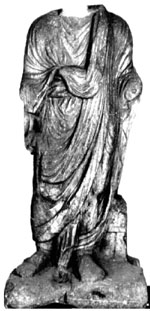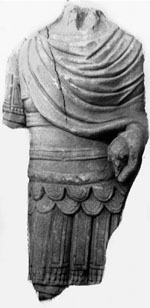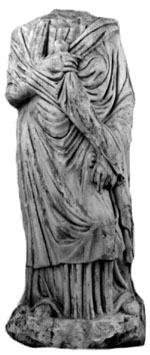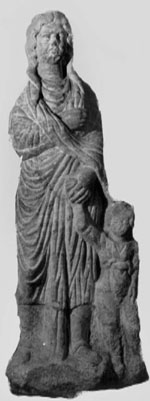
Burying rites and rituals are an important part of a community’s spiritual patrimony. They offer valuable information concerning the beliefs of the group, its ethnicity and the influences to which it is subjected. The study of the funerary monuments from Roman Dacia, as visible evidence of the funerary beliefs and praxis of the population, completes the image drawn by studying other aspects of provincial life.
No traces of Dacian funerary rites dating from late Latène period, the age of the Dacian kingdom, were identified. This absence rendered impossible any direct connection between previous funerary practices and the ones attested in the Roman province Dacia. Under these circumstances it can be inferred that the funerary monuments from Dacia were the product of the diversified society of the province. The types selected, the techniques employed, the shapes and sizes were determined by the colonists’ origin, their social status and fashion influences.
The importance of studying the funerary monuments from Dacia for the understanding of the complex social tableau of the province is determined by the importance held by the exterior manifestation of reverence towards the dead in Roman society. The existence of several collegia with funerary attributions must be seen under the same perspective. These associations subsidized funerary expenses or provided their members with a resting place inside their funerary constructions.
Almost all of the funerary monument types, characteristic to the Danubian provinces were identified in Dacia. They are, in their turn, a proof of the degree of integration of this province in the artistic and mental structures of the Empire during the 2nd and 3rd centuries AD. From this point on, we will try to review the funerary constructions identified, or presumed in Dacia, starting with the ample ones, which are less common, and going to the simpler ones which are better documented, hence more accessible to study due to their number.
One of the most common ways of separating the funerary space from the laic one is building a funerary precinct. This type of construction appeared in the last century of the Republic and became widespread at the beginning of the Empire. The delimitation of the perimeter was made either through a row of pilasters or through a wall limited by corner pilasters which occasionally resembled altars.
Such precincts existed in Dacia, as in any other western province of the Empire. Alas, they were often catalogued as a different type of structure at the moment of their discovery. This is the case with the funerary precinct from Valea Draşcovului , the western cemetery of Sarmizegetusa, which was initially believed to be a mausoleum. Inside the structure two brick- sarcophaguses and an andesite one were found, together with the bases of two monuments, one of which might have been an aedicula.
Another funerary precinct is the so-called "sub-urban villa" from the eastern necropolis of Sarmizegetusa. The initial interpretation is undermined by the absence of the archaeological material which could prove the existence of a building. We have here two successive precincts, over-posted. One of these precincts contains the foundation of the feminine statue which was previously found in the same area.
The discovery of architectonic features specific to the funerary precincts in several Roman settlements is a proof of their spreading in the important centers of Dacia. Corner-pilasters were identified at Apulum, Potaissa, and Gherla, while funerary lions on semi-columns were found at Micia, Apulum and Potaissa.
The vast funerary precincts could turn into genuine sepulchral gardens, like the ones attested at Rome and Pompeii. A versified inscription on a sarcophagus from Romula seems to indicate the existence of one in this town of Dacia. It surrounded the tomb of Aelius Iulius Iulianus, decurio, aedil, and quaestor of the colonia.
Another type of high-standing funerary structures is the mausoleum, an ample construction which mimics the shape of temples or houses. The mausoleums which imitated the classical temples were generally destined to senatorial or equestrian rank personalities, as indicted by the examples from Rome and Ostia. It is highly improbable that such constructions existed in Roman Dacia. On the other hand, the other type of mausoleums, the house-like one, built of bricks from Trajan on, can be identified in this province due to some specific types of funerary inscriptions
In this respect, the large inscriptions set above the entrance of the mausoleums refer to all of the family members set to rest inside. Several plaques have been pointed as entry-plates in Ulpia Traiana Sarmizegetusa.
One of them mentions the construction of a monument or funerary edifice by Aelia Adiuta and her sons, for herself and her husband (IDR III/2, 371). They were a highly ranked equestrian family, in the elite of the colony.
There are other inscriptions, mentioned by various scholars, but unfortunately lost today; they seem to have adorned the entrance of high-society mausoleums from Sarmizegetusa (IDR III/2, 370, 379, and 411).
Another type of inscription which hints at the existence of a mausoleum to foster it is the locullus plaque. Their purpose was to close the small-sized niche inside the mausoleum were the funerary urn was placed. There are several such plaques in Dacia, identified after their size and text. Some seem to have obturated double niches.
The large number of such inscriptions found in Sarmizegetusa and which commemorate imperial slaves and freedmen or their families point to the existence in this colony, which was the headquarters of the financial administration of the province, of a collective mausoleum of familiae Caesaris. They were not the only ones which preferred house-like mausoleums as resting places; several loculli plaques belonging to middle class people were found, like the inscription IDR III/2, 427, which mentions a certain Macrinus, probably a merchant from Augusta Treverorum, laid to rest by two comrades with Celtic names.
Several other loculli plaques indicate the preference for this type of funeral and the existence of familial mausoleums belonging to middle-class families. Also, it is very probable that the collegia funeraticia owned such constructions for their members’ common use.
The last type of inscriptions which indicate the presence of mausoleums in Dacia is represented by the arcosolium plaques.
The house-like mausoleum built of brick appears in Rome in Trajan’s time as a predilect funerary monument for imperial slaves and freedmen. It was adopted in Dacia by the same category of clerks and soon after that by the middle class also. Once inhumation became predilect in Severan time, the mausoleums became popular with the provincial elites, especially when they were built in the cemetery of one’s country villa rather than in the town’s necropolis. The casket containing the body was placed in a niche which was locked with a plaque similar in size and aspect to a sarcophagus lid, which it was emulating. These arcosolium plaques were decorated with vegetal motifs and participants to the mythological funerary procession; they bore the epitaph of the deceased laid to rest inside the respective niche.
Tumular mausoleums are also very interesting. Being of Hellenistic origin, they were adopted by the Romans in the 1st century BC , first by the senators, that by the equestrian order in the 1st century AD. Soon they decline in the preference of the capital but become popular in the western provinces during the 2nd century AD, especially where a tumuli tradition existed previous to the Roman occupation. The existence of this type of monument in Dacia must be placed under the influence of the Norico-Pannonian colonists. Until now, two such constructions are found in this province.
The first one was discovered at the beginning of the 20th century at Ulpia Traiana Sarmizegetusa. It is a circular construction with 21m diameter, composed of an impressive cobble and mortar foundation and an elevation which, after the founders of the monument, could have hardly be more than 1m height. Two rows of limestone blocks, curved in order to form a closed circle, were interlocked horizontally through iron-cramps and lead. .
The rough aspect of the blocks on the inside faces, together with the presence inside the mausoleum of a clay mantle, plea for the tumular nature of the construction. According to the inscription previously found in the same place, it belonged Q. Aurelius Tertius, decurio et flamen coloniae Sarmizegetusae (IDR III/2, 388). He is mentioned in another inscription which is dated in 142 (CIL III 1448), which places the construction of the building at the middle of the 2nd century AD. The interior of the tumular mausoleum was ravished by robbers; hence the main tomb could not be identified. Out of the funerary monument only the inscription mentioned above and a giant pine cone remained.
The other tumular mausoleum known in Dacia was recently discovered in Alburnus Maior (Roşia Montană) area. The circular wall with a diameter of 9 meters is composed of two superposed assizes, resting on a base of well-shaped blocks. The substruction is made of split stone. The blocks which form the wall are horizontally interconnected with wooden-cramps.
The discovery in situ of portions of the two assizes, of cornice blocks and architectonic elements of the funerary monument allowed the reconstruction of the funerary building.
Two main tombs with brick sarcophaguses were found inside the tumular mausoleum.
Another type of funerary construction is the aedicule. They are temple-like constructions placed on a pedestal which was usually inscribed with the deceased’s epitaph; his image, either a statue or a relief, was the central point of the aedicule. The absence in Dacia of funerary inscriptions carved directly on stone blocks is not an argument for the absence of monumental aedicule. On the contrary, their existence is hinted by the giant pinea discoveries and by the large number of funerary statues found especially in the important centers of the province.
| Place of discovery |
Male representations |
Female representations |
Children representations |
| Sarmizegetusa |
17 |
18 |
- |
| Apulum |
10 |
6 |
- |
| Napoca |
2 |
1 |
- |
| Drobeta |
- |
2 |
1 |
| Romula |
- |
1 |
- |
| Potaissa |
- |
2-3 |
- |
| Porolissum |
1 |
- |
- |
| Tibiscum |
1 |
- |
- |
| Dierna |
1 |
- |
- |
| Micia |
- |
1 |
- |
 |
 |
 |
 |
The absence of other elements which could be clearly attributed to monumental aedicules raises a lot of questions. It can be caused by employing other construction materials, like bricks or pebble, with columns and parts of entablature made of marble. Such fragments were found in Dacia, like pilasters decorated with divinities or vegetal patterns in Napoca and a Syrian type pediment with a Medusa portrait in Porolissum.
The situation is different in what the simple aedicules are concerned; this type is fairly common in Roman Dacia. They are simplified by the replacement of statues with reliefs depicting the deceased’s image. The transition from baldachin aedicules to the simple ones is illustrated by monuments which foster deep, full-sized high-reliefs, probably flanked by small columns.
The distribution of aedicules and components of aedicules indicates the preference for this type of monument in areas where funerary statues are rare, namely near auxiliary fortresses. This characteristic, together with the casual clothing of the people depicted in the reliefs seems to indicate the predilection for this type of monument amongst veterans and middle class members.
The simplest type of funerary monument preserved from Roman époque is the funerary stela. Its frequency when compared to other types of monuments mentioned above provides a wider access and numerous examples of provincial funerary art. The imagery of the funerary stelae consists of several predilect themes, like the funerary banquet, symbols of the deceased’s line of work, vegetal or zoomorphic symbols and ornaments.
Mihaela Mihalachi
Images and explanations to images: Sorana Mişca, Stanca Pitner
D. Alicu, C. Pop, V. Wollmann, Figured Monuments from Ulpia Traiana Sarmizegetusa. Sarmizegetusa Monograph 2, in BAR Int. Ser. 55, Oxford, 1979
H.Daicoviciu, D.Alicu, Colonia Ulpia Traiana Augusta Dacica Sarmizegetusa, Bucureşti, 1984
Al. Diaconescu, Statuaria Majoră în Dacia Romană, Cluj-Napoca, 2005)O. Floca, Sisteme de înmormântare din Dacia superioară romană, in Sargetia 1, 1941
O. Floca, Wanda Wolski, Aedicula funerară din Dacia Romană, in BMI 42/3
Funeraria Daco-Romana, coord. M. Bărbulescu, Cluj-Napoca, 2005
Patrimoniul cultural al Romaniei. Transilvania, Cluj-Napoca 2004
M. Simion, V. Apostol, Decebal Vleja, Alburnus Maior II, The Circular Funeral Monument, Bucureşti, 2004
R. Slotta, V. Wollmann, I. Dordea_Silber und Salz in Siebenbürgen, Bochum, 2002
L. Ţeposu-Marinescu, Funerary monuments in Dacia Superior and Dacia Porolissensis in BAR, Int. Ser. 128, Oxford, 1982
L. Ţeposu-Marinescu, Despre edicula funerară din Dacia romană, in SCIVA 25/3, 1974